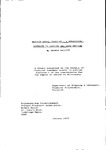HEAVIER GOODS VEHICLES - A BEHAVIOURAL APPROACH TO COSTING AND RATE SETTING
| dc.contributor.author | HALLETT, SHARON | |
| dc.contributor.other | Faculty of Arts, Humanities and Business | en_US |
| dc.date.accessioned | 2013-10-09T12:33:32Z | |
| dc.date.available | 2013-10-09T12:33:32Z | |
| dc.date.issued | 1987 | |
| dc.identifier | NOT AVAILABLE | en_US |
| dc.identifier.uri | http://hdl.handle.net/10026.1/2129 | |
| dc.description.abstract |
The debates which foreshadowed the introduction of the 38-tonne vehicle in May 1963 focused on two main issues: the environmental effects and the financial effects. Whilst it is recognised that there are many problems with evaluating the former, it is usually assumed that the latter are well documented and, therefore, easily enumerated. This thesis illustrates that this is not so. Costs are calculated using deficient published tables of operating costs and are based on the assumption that operators make wholly rational decisions based on a full knowledge of their total costs. The use of these assumptions can result in misleading conclusions . | |
| dc.description.sponsorship | Freight Transport Association, Hermes House, St. John's Road. Tunbridge Wells, KENT. | en_US |
| dc.language.iso | en | en_US |
| dc.publisher | University of Plymouth | en_US |
| dc.title | HEAVIER GOODS VEHICLES - A BEHAVIOURAL APPROACH TO COSTING AND RATE SETTING | en_US |
| dc.type | Thesis | |
| plymouth.version | Full version | en_US |
| dc.identifier.doi | http://dx.doi.org/10.24382/1582 |
Files in this item
This item appears in the following Collection(s)
-
01 Research Theses Main Collection
Research Theses Main


